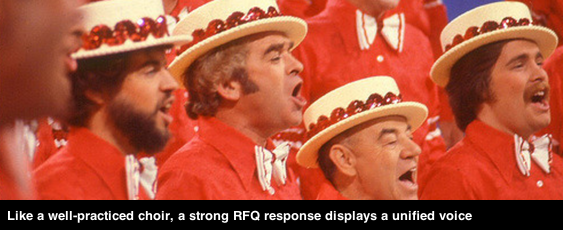Earlier posts provided an overview of RFQs, demonstrating capability to complete the RFP phase and contract, and creating confidence that the RFQ team is and will continue to stay aligned.
If you’re not familiar with AFP/P3 projects, please read the posts linked above.
The importance of a single voice response
Project sponsors (RFQ issuers) select for consortiums that not only have experience and capability, but are likely to remain intact and aligned throughout the RFP phase and the contract term.
In demonstrating unity, a track record of joint projects, together with partnering agreements and similar contractual mechanisms, are important—but the proposal itself also shows whether consortium members are on the same page.
Strong RFQ responses look and read as if developed by a single entity (which is what the consortium needs to be). In contrast, inconsistent messaging and a mix of structural, writing and graphics styles weaken any claim to a single guiding will and mind.
Components of a unified response
Assess your process and RFQ responses for the following:
- Consistent structure: Structure is the underlying framework behind a proposal section. Although some RFQ issuers provide detailed evaluation criteria that imply a structure, some sections (design approach, operating plan, etc.) may offer considerable flexibility in how to respond. If each major RFQ section (e.g. teaming, design, construction, operations, finance) includes a section on approach, for example, we recommend writing within a common information architecture. Following a framework can help authors from different companies create content that reflects alignment.
- Templates and content prompts: Preparing writers with templates and prompts at kickoff not only improves compliance in first drafts, it also promotes consistent presentation of similar information. See this post on proposal templates and content prompts.
- Unified messaging: All sections should reinforce the consortium’s strategy, expressing win themes with consistent language and arguments. While every consortium agrees on a set of win themes at kickoff, follow-up is needed to ensure they are reflected throughout the response.
- Consistent style: Below the level of structure is writing style. Since RFQs are persuasive documents, the language and syntax are often less technical than for RFQs. This encourages team members’ corporate personalities to creep into the writing, affecting sentence and paragraph structure, often making some sections more informal or “salesy” than others. A third party, such as Complex2Clear, can edit these different styles into a single voice response.
- Uniform quality: RFQs typically include a glossary of “official” terms and titles specific to the project. The consortium needs to go further, creating a proposal style guide of industry-specific acronyms, short forms for team members, the sponsor, reference projects, roles, committees, etc., how to handle the abbreviation in first-instance references, and any other items repeated throughout the response.
- Unified look and feel: The consortium logo, template and graphics (org charts, charts and tables, illustrations, callouts) need to align to a set of graphic standards across the entire proposal. Aligning to these standards is another logical role for third party support.
Achieving single voice is hard
The effort to complete a compliant and responsive proposal can easily crowd out the items above. Successful consortiums recognize this, start early, and engage the resources they need.


